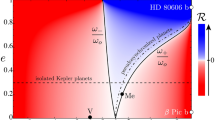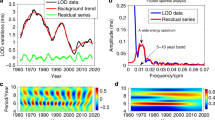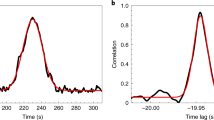Abstract
THE question of a link between changes in the Earth's spin rate and the activity of the Sun is of topical interest, and there is good evidence that the changing length of day is influenced by the mean level of solar activity1,2. The possibility of a one-to-one correlation between specific events on the Sun and specific changes in the length of day has remained more controversial, however, although there was a suggestion of such an effect associated with the great solar storm of 1959 (refs. 3–5) Specifically, Danjon suggested3–5 that there was an increase in the length of day when the nucleonic component of solar cosmic rays increased ; this was in addition to the usual steady increase in the length of day. Other observers questioned the reality of this effect (for a discussion of the controversy see ref. 6), and because the 1959 solar storm was the greatest recorded since the time of Galileo, there was no immediate hope of an independent test of Danjon's claim. In August 1972, however, an even greater disturbance occurred on the Sun7–9. It seemed to us that this might provide the ideal opportunity to resolve the controversy, and we have indeed found a discontinuous change in the length of day, and a change in the rate of change of the length of day (a glitch) immediately after that event. Changes in the length of day, and thus in the spin rate of the Earth, are revealed by regular measurements of Universal Time (UT) carried out at many observatories around the world. For our purpose, we are interested in UT2, the version of Universal Time with the effects of the Chandler Wobble and seasonal variations removed. The difference between Atomic Time (AT) and UT2 shows, on average, a monotonic increase as the Earth's spin slows down and the length of day increases.
This is a preview of subscription content, access via your institution
Access options
Subscribe to this journal
Receive 51 print issues and online access
$199.00 per year
only $3.90 per issue
Buy this article
- Purchase on Springer Link
- Instant access to full article PDF
Prices may be subject to local taxes which are calculated during checkout
Similar content being viewed by others
References
Challinor, R. A., Science, 172, 1022 (1971).
Gribbin, J., Science, 173, 558 (1971).
Danjon, A., CR Acad. Sci. Paris., 254, 2479 (1962).
Danjon, A., CR Acad. Sci. Paris., 254, 3058 (1962).
Danjon, A., Notes et Informations de l'Observatoire de Paris, 8 No. 7 (1962).
Schatzman, E., in The Earth–Moon System (edit. by Cameron A. G. W., and Marsden, B. G.), 12 (Plenum, New York, 1966).
Pomerantz, M. A., and Duggal, S. P., Nature, 241, 331 (1973).
Chupp, E. L., Forrest, D. J., Higbie, P. R., Surie, A. N., Tsai, C., and Dunphy, P. P., Nature, 241, 333 (1973).
Mathews, T., and Lanzerotti, L. J., Nature, 241, 335 (1973).
Macdonald, N. J., and Roberts, W. O., J. Geophys. Res., 65 529 (1960).
Roberts, W. O., and Olsen, R. M., J. Atmos. Sci., 30, 135 (1973).
Author information
Authors and Affiliations
Rights and permissions
About this article
Cite this article
GRIBBIN, J., PLAGEMANN, S. Discontinuous Change in Earth's Spin Rate following Great Solar Storm of August 1972. Nature 243, 26–27 (1973). https://doi.org/10.1038/243026a0
Received:
Issue Date:
DOI: https://doi.org/10.1038/243026a0
This article is cited by
-
A relation between solar activity and the Earth's rotation
Earth, Moon, and Planets (1990)
-
Planetary Alignments, Solar Activity and Climatic Change
Nature (1973)
-
Rotation of the Earth during the 1972 Solar Event
Nature (1973)
Comments
By submitting a comment you agree to abide by our Terms and Community Guidelines. If you find something abusive or that does not comply with our terms or guidelines please flag it as inappropriate.



